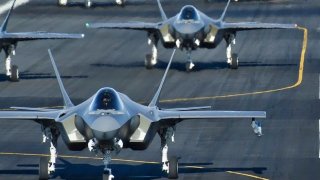The Block 4 F-35 Fighter Has the Makings of a 'Stealth' Classic
The F-35 Lightning II is set for significant improvements with the Block 4 upgrade, enhancing its electronic hardware, software, and core processor as part of Technology Refresh 3 (TR-3).
Summary and Key Points You Need to Know: The F-35 Lightning II is set for significant improvements with the Block 4 upgrade, enhancing its electronic hardware, software, and core processor as part of Technology Refresh 3 (TR-3).

-Though TR-3 faced delays, a "truncated" version has now been approved, allowing F-35 deliveries to resume.
-Additionally, Pratt & Whitney's F135 Engine Core Upgrade (ECU) promises increased durability and performance for all F-35 variants, aiming for a $40 billion lifecycle cost saving.
-The ECU will be integrated into new F-35s and retrofitted into existing ones, with first engine tests slated for 2026 and deliveries by 2029.
The F-35 Lightning II is About to Get Even Better
The Lockheed Martin F-35 Lightning II has already been touted as one of the most advanced and capable combat aircraft in service today. It could soon be further improved as part of its Block 4 upgrade that will enhance the fifth-generation stealth fighter’s electronic hardware and software, while dozens of other systems will be updated. That will include the aircraft’s core processor and memory as part of the still ongoing Technology Refresh 3 (TR-3).
Delays to TR-3 resulted in the U.S. Department of Defense (DoD) refusing to accept deliveries of the aircraft, but this month, the head of the program executive office approved the “truncated” version of the TR-3. That will allow deliveries of the F-35 to resume.
In addition, the F-35 could be flying with an enhanced F135 turbofan engine, as Pratt & Whitney announced it had completed the F135 Engine Core Upgrade’s (ECU) preliminary design review (PDR), which affirmed that the ECU’s design remains on schedule and according to the company has been “exceeding expectations.” The upgrade to the F135 engine will increase its durability and performance, while it has been optimized for all three F-35 variants. The upgrade was touted as potentially yielding $40 billion in lifecycle cost savings.
“Pratt & Whitney is upgrading the F135 engine with technology from multiple development programs to deliver increased capability and performance for the warfighter,” said Chris Johnson, vice president of Pratt & Whitney’s F135 program. “Upgrading the F-35’s propulsion system to ECU is a critical step toward ensuring the F-35 remains the world’s premier air dominance fighter.”
The Pentagon has selected the F135 ECU as the modernization solution for the F-35’s propulsion system after it concluded that the engine maker was the only firm with the “experience, special skills, proprietary technical documentation, software/algorithms, and technical expertise required to furnish the supplies and services.” However, it is unclear what other engine makers may have been considered.
Pratt & Whitney received a $115 million Pentagon contract in December 2022 to support the F135 engine enhancement program. The new F135 ECU will be integrated into new F-35 Lightning IIs during production and retrofitted at F135 sustainment facilities. Pratt & Whitney has delivered more than 1,200 F135 production engines, which have more than 860,000 combined flight hours recorded.

“The PDR was a successful first step toward the capability the ECU will provide in meeting the challenging performance and durability requirements of the F135,” said U.S. Navy captain. Mitchell Grant, the F-35 propulsion program manager. “The ECU will ensure that the U.S. and our international partners remain well positioned to outpace adversary threats.”
Pratt & Whitney has set a 2029 target for the delivery of the upgraded F135 engines, with the first engine tests to begin in 2026. The company has said the program remains on track and that it has been hitting its schedule milestones.
About the Author
Peter Suciu is a Michigan-based writer. He has contributed to more than four dozen magazines, newspapers, and websites with over 3,200 published pieces over a twenty-year career in journalism. He regularly writes about military hardware, firearms history, cybersecurity, politics, and international affairs. Peter is also a Contributing Writer for Forbes and Clearance Jobs. You can follow him on Twitter: @PeterSuciu. You can email the author: [email protected].
All images are Creative Commons and/or Shutterstock.


